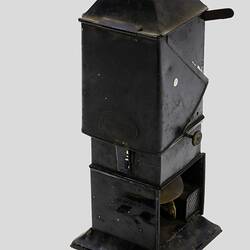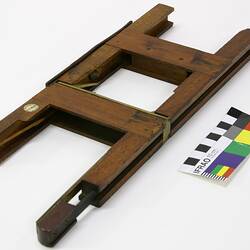Summary
Large metal magic lantern projector used to project images. Lanterns of this size would have been used professionally.
While the invention of the magic lantern is generally seen to be in the 17th century, its greatest popularity as an optical projector spans the late18th century to the early decades of the 20th century. It was used both as a means of entertainment and education.
This lantern projector is part of the Francis Collection of pre-cinematic apparatus and ephemera, acquired by the Australian and Victorian Governments in 1975. David Francis was the curator of the National Film and Sound Archive of the British Film Institute as well as being a co-founder of the Museum of the Moving Image in London, which was operational between 1988 and 1999.
Physical Description
Large Lantern Projector made from black coated metal. The body of the Lantern Projector is a black, rectangular box. Access to the illumination chamber is via a hinged back door which lifts up. The illuminant slid into the chamber along two rails. The top of the lantern has a raised, rectangular platform with a rectangular hole in the top for attaching secondary object (chimney). Two small handles are attached in front of this platform. A row of eight circular ventilation holes run along the upper edge of the long sides. The lantern features a lens barrel with two glass lenses (the outer one missing) and a condenser.
More Information
-
Collection Names
-
Collecting Areas
-
Acquisition Information
Loan & Subsequent Donation from Australian Film Institute (AFI), Mr David Francis, by Nov 1990
-
Collector
Mr David Francis, London, Middlesex, England, Great Britain, 1990
-
Classification
-
Category
-
Discipline
-
Type of item
-
Overall Dimensions
192 mm (Length), 555 mm (Width), 355 mm (Height)
-
Keywords
Lantern Projectors, Magic Lanterns, Pre-Cinema Moving Images, Projectors


